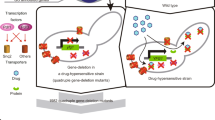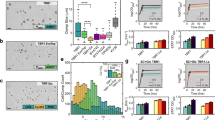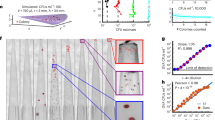Abstract
The identification of new antifungal molecules is an important goal of current anti-infective research. To achieve this goal, alternatives to traditional growth inhibition–based screening have been developed in recent years. In this study, we describe an assay to detect molecules that disrupt yeast cell integrity by using the release of adenylate kinase (AK) into culture medium as a reporter of yeast cell lysis. The protocol is applicable to 96- and 384-well microtiter plate formats; uses a commercially available luminescence assay kit to detect AK activity; is more sensitive than traditional growth-based assays; and is specific for fungicidal compounds. In the high-throughput setting, the procedure provides excellent Z′ scores (0.75–0.9), making it a highly robust assay. The AK assay is performed in a single microtiter plate using an 'add and read' procedure that can be completed in a single work day.
This is a preview of subscription content, access via your institution
Access options
Subscribe to this journal
Receive 12 print issues and online access
$259.00 per year
only $21.58 per issue
Buy this article
- Purchase on Springer Link
- Instant access to full article PDF
Prices may be subject to local taxes which are calculated during checkout

Similar content being viewed by others
References
Patterson, T.F. Advances and challenges in management of invasive mycoses. Lancet 366, 1013–1025 (2006).
Shorr, A.F., Gupta, V., Sun, X., Johannes, R.S., Spalding, J. & Tabak, Y.P. Burden of early-onset candidemia: analysis of culture-positive bloodstream infections from a large US database. Crit. Care Med. 37, 2519–2526 (2009).
Spanakis, E.K., Aperis, G. & Mylonakis, E. New agents for the treatment of fungal infections: clinical efficacy and gaps in coverage. Clin. Infect. Dis. 43, 1060–1068 (2006).
Nucci, M. & Perfect, J.R. When primary antifungal therapy fails. Clin. Infect. Dis. 46, 1426–1433 (2008).
Wilson, L.C., Reyes, C.M., Stolpman, M., Speckman, J., Allen, K. & Beney, J. The direct cost of systemic fungal infections. Value Health 5, 26–34 (2002).
Payne, D.J., Gwynn, M.N., Dolmes, D.J. & Pompliano, D.L. Drugs for bad bugs: confronting challenges of antibacterial discovery. Nat. Rev. Drug Discov. 6, 29–40 (2007).
Tampakakis, E., Okoli, I. & Mylonakis, E.A. C. elegans-based, whole animal in vivo screen for the identification of antifungal compounds. Nat. Protoc. 3, 1925–1931 (2008).
Pierce, C.G., Uppuluri, P., Tristan, A.R., Wormley, F.L. Jr., Mowat, E. & Lopez-Ribot, J.L. A simple and reproducible 96-well plate-based method for the formation of fungal biofilms and its application to antifungal susceptibility testing. Nat. Protoc. 3, 1494–1500 (2008).
Krysan, D.J. & DiDone, L. A high-throughput screening assay for small molecules that disrupt yeast cell integrity. J. Biomol. Screen 13, 657–664 (2008).
Cannon-Clarke, A., Hulse, G.A., Clifton, L. & Cantrell, I.C. The use of adenylate kinase measurement to determine the causes of lysis in lager yeast. J. Am. Soc. Brew. Chem. 61, 152–156 (2003).
Cabib, E., Blanco, N., Grau, C., Rodriguez-Pena, J. & Arroyo, J. Crh1p and Crh2p are required for the cross-linking of chitin to β(1,6)-glucan in the Saccharomyces cerevisiae cell wall. Mol. Microbiol. 63, 921–935 (2007).
Graybill, J.R., Burgess, D.S. & Hardin, T.C. Key issues concerning fungistatic versus fungicidal drugs. Eur. J. Clin. Microbiol. Infect. Dis. 16, 42–50 (1997).
Sloan, D.J., Dedicoat, M.J. & Lallo, D.G. Treatment of cryptococcal meningitis in resource limited settings. Curr. Opin. Infect. Dis. 22, 455–463 (2009).
National Committee for Clinical Laboratory Standards. Reference Method for Broth Dilution Antifungal Susceptibility Testing of Yeasts. Approved standard M27-A2 (National Committee for Clinical Laboratory Standards. Wayne, PA, 2002).
Bruno, V.M., Kalachikov, S., Subaran, R., Nobile, C.J., Kyratsous, C. & Mitchell, A.P. Control of the C. albicans cell wall damage response by transcriptional regulator Cas5. PLOS Pathog. 2, e21 (2006).
Acknowledgements
We thank Alan Smrcka and Michael Burroughs of the University of Rochester Medical Center High Throughput Screening Core Facility for assistance with robotics. This work was supported by grants from the Strong Children's Research Center (D.J.K.) and the National Institutes of Health 1R01AI07503 (D.J.K.).
Author information
Authors and Affiliations
Contributions
D.J.K. and B.K.B. designed the experiments. L.D., T.S. and B.K.B. performed the experiments. B.K.B. and D.J.K. analyzed data. D.J.K. prepared the paper.
Corresponding author
Ethics declarations
Competing interests
The authors declare no competing financial interests.
Rights and permissions
About this article
Cite this article
DiDone, L., Scrimale, T., Baxter, B. et al. A high-throughput assay of yeast cell lysis for drug discovery and genetic analysis. Nat Protoc 5, 1107–1114 (2010). https://doi.org/10.1038/nprot.2010.47
Published:
Issue Date:
DOI: https://doi.org/10.1038/nprot.2010.47
Comments
By submitting a comment you agree to abide by our Terms and Community Guidelines. If you find something abusive or that does not comply with our terms or guidelines please flag it as inappropriate.



